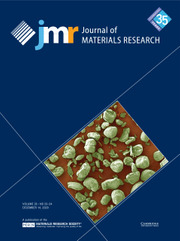Crossref Citations
This article has been cited by the following publications. This list is generated based on data provided by
Crossref.
Kim, Minsoo
Marimuthu, Karuppasamy Pandian
Lee, Jin Haeng
and
Lee, Hyungyil
2016.
Spherical indentation method to evaluate material properties of high-strength materials.
International Journal of Mechanical Sciences,
Vol. 106,
Issue. ,
p.
117.
Čech, Jaroslav
Haušild, Petr
Kovářík, Ondřej
and
Materna, Aleš
2016.
Examination of Berkovich indenter tip bluntness.
Materials & Design,
Vol. 109,
Issue. ,
p.
347.
Goto, Kenta
Watanabe, Ikumu
and
Ohmura, Takahito
2019.
Determining suitable parameters for inverse estimation of plastic properties based on indentation marks.
International Journal of Plasticity,
Vol. 116,
Issue. ,
p.
81.
Lee, Kwangmin
Marimuthu, Karuppasamy Pandian
Lee, Jin Haeng
Rickhey, Felix
Han, Jungmoo
and
Lee, Hyungyil
2020.
Determination of crack-free mechanical properties of brittle materials via single nanoindentation.
International Journal of Solids and Structures,
Vol. 191-192,
Issue. ,
p.
8.
Chen, Hui
Cai, Li-xun
and
Li, Chuanxi
2020.
An elastic-plastic indentation model for different geometric indenters and its applications.
Materials Today Communications,
Vol. 25,
Issue. ,
p.
101440.
Marimuthu, Karuppasamy Pandian
Lee, Kwangmin
Han, Jungmoo
Rickhey, Felix
and
Lee, Hyungyil
2020.
Nanoindentation of zirconium based bulk metallic glass and its nanomechanical properties.
Journal of Materials Research and Technology,
Vol. 9,
Issue. 1,
p.
104.
Goto, Kenta
Watanabe, Ikumu
and
Ohmura, Takahito
2020.
Inverse estimation approach for elastoplastic properties using the load-displacement curve and pile-up topography of a single Berkovich indentation.
Materials & Design,
Vol. 194,
Issue. ,
p.
108925.
Hwang, Yewon
Marimuthu, Karuppasamy Pandian
Kim, Naksoo
Lee, Cheolsoo
and
Lee, Hyungyil
2021.
Extracting plastic properties from in-plane displacement data of spherical indentation imprint.
International Journal of Mechanical Sciences,
Vol. 197,
Issue. ,
p.
106291.
Goto, Kenta
Ikeda, Ayako
Osada, Toshio
Watanabe, Ikumu
Kawagishi, Kyoko
and
Ohmura, Takahito
2022.
High-Throughput Evaluation of Stress–Strain Relationships in Ni–Co–Cr Ternary Systems Via Indentation Testing of Diffusion Couples.
SSRN Electronic Journal ,
Han, Giyeol
Marimuthu, Karuppasamy Pandian
and
Lee, Hyungyil
2022.
Evaluation of thin film material properties using a deep nanoindentation and ANN.
Materials & Design,
Vol. 221,
Issue. ,
p.
111000.
Goto, Kenta
Ikeda, Ayako
Osada, Toshio
Watanabe, Ikumu
Kawagishi, Kyoko
and
Ohmura, Takahito
2022.
High-throughput evaluation of stress–strain relationships in Ni–Co–Cr ternary systems via indentation testing of diffusion couples.
Journal of Alloys and Compounds,
Vol. 910,
Issue. ,
p.
164868.
Jeong, Kyeongjae
Lee, Kyungyul
Lee, Siwhan
Kang, Sung-Gyu
Jung, Jinwook
Lee, Hyukjae
Kwak, Nojun
Kwon, Dongil
and
Han, Heung Nam
2022.
Deep learning-based indentation plastometry in anisotropic materials.
International Journal of Plasticity,
Vol. 157,
Issue. ,
p.
103403.
Park, Soowan
Fonseca, João Henrique
Marimuthu, Karuppasamy Pandian
Jeong, Chanyoung
Lee, Sihyung
and
Lee, Hyungyil
2022.
Determination of material properties of bulk metallic glass using nanoindentation and artificial neural network.
Intermetallics,
Vol. 144,
Issue. ,
p.
107492.
Sousa, Bryer C.
Aindow, Mark
Lee, Seok-Woo
Lados, Diana
Spangenberger, Anthony G.
Sample, Christopher M.
and
Cote, Danielle L.
2023.
Advances in Cold Spray.
p.
205.
Satošek, Roman
Pepelnjak, Tomaž
and
Starman, Bojan
2023.
Characterisation of out-of-plane shear behaviour of anisotropic sheet materials based on indentation plastometry.
International Journal of Mechanical Sciences,
Vol. 253,
Issue. ,
p.
108403.



